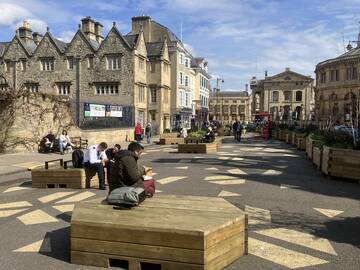This is an excellent set of ideas. We support both the broader goals of the COMPF project and the list of specific ideas, though the latter will need to be fleshed out with details before we can see how they will actually work. There are also a few areas we would have liked to have seen included that weren't.
The opportunities for improvement are huge. The public realm in the city centre is of quite poor standard, making it relatively unattractive for residents or visitors: central Cambridge is significantly nicer, to make the obvious comparison, as are the centres of York, Bath, or even Birmingham. (Though to be fair, some of those cities are significantly less pleasant than Oxford just outside the centre.)
Walking around central Oxford can be quite unpleasant: narrow, cramped footways, awkward and hostile crossings where people are almost forced to cross on red, too much motor traffic (including high bus flows in some locations), and poor separation from cycling.
There is also poor provision for cycling: most notably in the absence of accessible east-west and north-south routes through the centre, and the lack of any kind of safe, coherent and consistent cycling infrastructure along Banbury and Woodstock Rds.
more
Paris has been radically reallocating space from motor vehicles to cycling and public space. The most visible changes are the dramatic cycle tracks (Rue du Rivoli, etc) and the space reallocation (Place de la Bastille, etc). But there are less visible changes that are just as important, in particular low traffic streets and circulation system changes. And the political and legal and design context of these changes is important.
This is based on three days I spent in Paris in May 2024, as part of a London Cycling Campaign study tour. One day involved discussions with the deputy mayors in charge of transport for the 14th and 20th arrondissements and a presentation on the VIF "Ile-de-France cycle network" (with some cycling to get to the meetings); a second day involved cycling around looking at infrastructure, guided by campaigners from MDB and Paris en selle; and I had two half-days largely spent walking around by myself.
more
The legal changes to Broad St have been made permanent, but the current layout is clearly still temporary, in the sense that many of the features of the area no longer reflect its actual use. Most obviously, most of the existing kerbs are now redundant, or in the wrong place, and serve only as a trip hazard.

sitting around
A proper plan for Broad St needs to be part of a redesign of the entire area of the city centre north of High St and east of Cornmarket, as envisaged in the Oxford Preservation Trust's proposals twenty years ago, and any such plan will be dependent on funding which is not yet available. But there are possibilities in the management of vehicle access and parking for improvements that could plausibly be implemented in the shorter term. more

